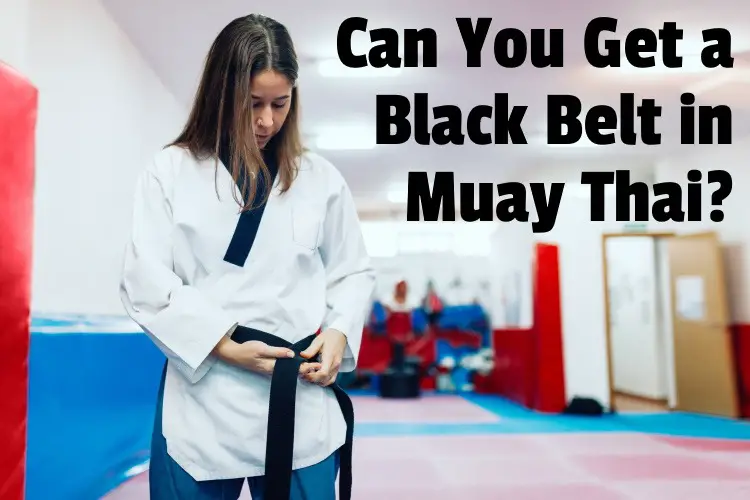
Virtually all martial arts have a ranking system that’s reflected in the color of belts practitioners wear. What about Muay Thai? Can you get a black belt in Muay Thai?
Here’s what I found out:
Muay Thai does not have a belt ranking system. However, some organizations outside of Thailand have a ranking system for their schools, especially schools that cater to children as belt progressions often keep kids engaged longer in martial arts.
So, they are limited to certain schools.
In this article, we’ll explore in greater detail why some schools use belts and why others don’t. But we’ll also look at how Muay Thai students measure progress if they don’t have a belt system. Finally, we’ll look at how long it takes to master Muay Thai, whether or not you get that black belt.
Let the fun begin…
After a successful season in his first year as a competitor “The Blade” gets what he deserves: His first Muay Thai amateur championship belt pic.twitter.com/GRUwpg3oYM
— Ralf Stege (@DoD_Official) October 8, 2017
Can you get belts in Muay Thai?
Officially, Muay Thai has no belt progression system whatsoever. However, belt systems have been added to many schools in the US. Muay Thai in Thailand is a highly competitive and commercial sport. As such, what counts are championship belts, not colored belts denoting rank.
The belt ranking system started with Judo in the late 19th century and was eventually copied by other martial arts.
It is meant to be an indication of competence (not mastery) and in most martial arts, practitioners have to be tested before they are awarded a belt that is fitting of their grasp of the art.
This tradition is not a part of Muay Thai.
MT fighters do not think of rank in the sense of colored belts. Because it’s a highly competitive sport where there are many contests, a fighter’s actual skills as reflected in their wins are what counts.
They often wear an armband (known as a prajiad or praciat), not as an indicator of rank, but for protection and good luck. And in most cases, you don’t wear a traditional gi, instead opting for Muay Thai shorts and a T-shirt.
But in the West, some schools have adopted a traditional belt ranking system.
Naturally, you can get a black belt from such schools. But, note that it means nothing to the wider Muay Thai community!
Muay Thai photography at Gefle Fight Center. #muaythai #muaythaiphotography #thainyrkkeily #fotograf #valokuvaus pic.twitter.com/XfQyKuV4di
— millakvick │ Photography (@millakvick) May 16, 2021
What is a Muay Thai black belt?
Traditionally, Muay Thai has no belt ranking system. As such, there is no black belt or other colors of belt. In traditional Muay Thai, only wins against an opponent are seen as a sign of mastery.
What a fighter accomplishes in an actual contest is what shows their “rank, not some colored belts as it is common in other martial arts.”
In Thailand, most people who gravitate toward Muay Thai do it for the money.
They start very early, at times as early as 7, and by the time they are 25-30, some have retired. Because it is a national sport, the competition is always intense.
So, actual Muay Thai fighters don’t care about colored belts, their focus is on championship belts.
These, you’d agree with me, are the actual indicators of rank. They are better than belts because they are dynamic.
After earning a belt in martial arts where they are used, it’s possible for a fighter to simply coast and rest on their laurel.
That’s not common in the real MT world where most fighters regularly engage in paid contests.
Interested in picking up Muay Thai?
I wrote the ultimate guide for you where I shared its key pros and cons. You can learn MT relatively fast, it’s awesome for self-defense and fitness. Get the full lowdown in a recent article of mine.
Just click the link to read it on my site.
Blessed and humbled to have received my ceremonial arm bands for achieving the next step in my Muay Thai training 🙏🏻💪🏻👊🏻 pic.twitter.com/AIn21cDTTT
— Zack Perkins (@zjp44) November 18, 2016
Do some Muay Thai schools use belts?
Some Muay Thai schools in the United States and other western countries have adopted the use of a colored belt ranking system as is commonly practiced in other martial arts. But it may be an armband or color of shorts and not necessarily a belt.
The Bang Muay Thai is one such school.
Instead of traditional colored belts, it uses colored armbands as a ranking system.
The Bang Muay Thai school is based in the U.S. and it teaches a modified version of MT — a variant that’s a bit different from the traditional form. It’s more adapted for MMA.
TJ Dillashaw, a two-time bantamweight UFC champion is a product of Bang Muay Thai.
The World Thai Boxing Association, also based in the U.S. is also focused on offering a structured and graduated approach to learning MT, and it offers a ranking system, too. It uses armbands, not belts, as indicators of rank.
Some MT purists believe the ranking system should not be adopted, while others believe that exceptions should be made.
They argue that children and young people learning the art often want something tangible that indicates they are making progress.
Having worked with hundreds of kids back when I ran a martial arts school, I can attest that a colored belt system encourages kids to stick around a martial arts school longer.
So for many school owners with a large children’s program, belt systems are used to help keep them in business. They make more money the longer a child sticks around.
And without a belt system, many kids would quit in under 6 months.
Muay Thai. | Shot on #GoProHERO7https://t.co/U97P4Dxohh#joshidaniel #photography #photographer #travelblogger #TravelTuesday #travelphotography #traveling #travelling #Traveller #Wanderlust #MuayThai #GoPro #Thailand #travelgram #traveltheworld #instago pic.twitter.com/rnkthUIrpu
— joshi daniel (@joshidaniel) December 21, 2018
How long does it take to become proficient in Muay Thai?
As a general rule, it takes 1 year to become proficient at Muay Thai, 3 years to master the basics, 7 years to become really good, and 10 years to earn a black belt or master Muay Thai if the school does not use belts. This is assuming a practice regime of training 2-3 times per week.
Professional MT fighters often train twice each day, 6 days a week!
And, the training is grueling, especially since they are focused on competitions. The average person would most probably not have the time or the capacity for such a program.
To see impressive results within a year (or even 6 months), I’ll suggest you train at least 3 times each week. To improve your game, after 12 months of training, you should be ready to start doing tournaments or competitions.
Aim for a major fight every 6 months.
Some pros fight more frequently. If you can manage at least two good fights each year coupled with more intense training, you ought to be awesome by your 7th year.
The reality in martial arts is that no one ever truly reaches a point where they feel like they’ve arrived. But, if you are consistent, by the 10th year, you ought to reach “mastery.”
One of the pupils in my class rocked up with this championship belt on Monday! He is now a European champion in Muay Thai!! I always thought I was the toughest in the class….maybe not so much now. pic.twitter.com/sS6QCK62xj
— Mr Crump (@MrCrump5) January 30, 2020
How long does it take to get a black belt in Muay Thai?
In schools with a belt system, it takes approximately 10 years to earn a black belt in Muay Thai. But, black belts are not awarded in many Muay Thai schools as traditionally, there is no ranking system.
And 10 years is a good indicator of mastery, belt or no belt. For most schools, the real “black belt” is winning in the arena, not in a piece of cloth worn around the waist.
As I’ve said, there is no belt ranking system in Muay Thai, especially in traditional schools and virtually all schools in Thailand.
But, there are many opportunities for fighters to gauge how competent they are.
It’s a bit like Western boxing where no one wears a belt to indicate status. Rather, folks compete for championship belts and money.
These fighters are onto something if you ask me.
But if you train 2-3 times (or more) per week for 10 years, you will become a great Muay Thai fighter, with or without a black belt.
And ultimately, it’s your skill and how you feel about yourself that matters more than a piece of cloth.
Conclusion
In the article, we checked out whether belts are used for ranking in Muay Thai.
No, they aren’t. MT fighters don’t care about colored belts and stuff like that. They compete for championship belts and money.
What of the armbands? They’re traditionally for protection and good luck.
Some schools have introduced the ranking system into MT, but truth be told, it’s not respected in the wider MT community. How long would it take to be good at MT?
In 12 months you should have the fundamentals down cold. But to level up, you’d need at least 3 years of consistent training.
